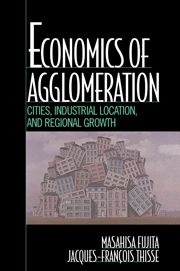Book contents
- Frontmatter
- Contents
- Acknowledgments
- 1 Agglomeration and Economic Theory
- PART I FUNDAMENTALS OF GEOGRAPHICAL ECONOMICS
- PART II THE STRUCTURE OF METROPOLITAN AREAS
- 6 The Spatial Structure of Cities under Communications Externalities
- 7 The Formation of Urban Centers under Imperfect Competition
- PART III FACTOR MOBILITY AND INDUSTRIAL LOCATION
- PART IV URBAN SYSTEMS AND REGIONAL GROWTH
- References
- Name Index
- Subject Index
7 - The Formation of Urban Centers under Imperfect Competition
Published online by Cambridge University Press: 05 June 2012
- Frontmatter
- Contents
- Acknowledgments
- 1 Agglomeration and Economic Theory
- PART I FUNDAMENTALS OF GEOGRAPHICAL ECONOMICS
- PART II THE STRUCTURE OF METROPOLITAN AREAS
- 6 The Spatial Structure of Cities under Communications Externalities
- 7 The Formation of Urban Centers under Imperfect Competition
- PART III FACTOR MOBILITY AND INDUSTRIAL LOCATION
- PART IV URBAN SYSTEMS AND REGIONAL GROWTH
- References
- Name Index
- Subject Index
Summary
INTRODUCTION
The analysis developed in the previous chapter sheds light on the emergence of centers within a city. There, the emergence of an urban center crucially depends on the existence of nonmarket interactions (externalities) among agents and is typical of the formation of a CBD involving high-level activities. However, in the real world, we also frequently observe the formation of clusters of stores selling similar goods (fashion clothes, restaurants, movie theaters, antiquity shops, etc.) or of employment centers in which different kinds of jobs are performed. In such cases, the agglomeration forces are created through market interactions between firms and consumers or workers. As seen in Chapter 2, for this to occur, one must consider increasing returns and imperfect competition. In this chapter, our purpose is to show how urban centers of different types, such as commercial areas or employment centers, may emerge under imperfect competition in the product or labor market. We will consider different market structures. The common thread of the various models considered here is that monopoly (or monopsony) power on the product (labor) market is needed for such agglomerations to emerge in equilibrium.
In Section 7.2, we suppose monopolistic competition with a continuum of firms selling differentiated varieties (Fujita 1986; 1988). Firms no longer assume that they can sell whatever they want at given market prices. Instead, each firm is aware that its optimal choice (location and price) depends on the demand for the variety it supplies.
- Type
- Chapter
- Information
- Economics of AgglomerationCities, Industrial Location, and Regional Growth, pp. 217 - 264Publisher: Cambridge University PressPrint publication year: 2002



